Hail the Chief!
Published in 18th-19th Century Social Perspectives, 18th–19th - Century History, Features, Issue 1 (Spring 1999), Volume 7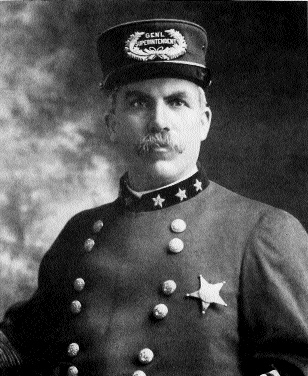
(Irish Traditional Music Archive, Dublin)
Consider the following scenario. Two musicians are comparing tunes. As one plays the other smiles appreciatively and enquires: ‘Where did you get it?’, to which the player replies: ‘’Tis in the book’. The listener nods. No further explanation is necessary. ‘The book’ in question—The Music of Ireland—was compiled by Francis O’Neill, collector, musician, adventurer, and Chief-of-Police, Chicago PD. He was born near Bantry, County Cork on 28 August 1849. He died in the city of his adoption at the age of eighty-seven. During his lifetime he proved to be amongst the most influential individuals in the preservation of that corpus of material known as Irish traditional music.
Early life
Francis was the youngest of seven children born to John O’Neill, a strong farmer from the townland of Tralibane, and Catherine O’Mahony.. It was an area severely affected by the famine, although the O’Neills would not appear to have suffered deprivation. It was also an area rich in music where the Irish language was still generally spoken. It is clear that Francis could converse and write in Irish, although English was undoubtedly the language of the home. His love of music came from his parents, both of whom were singers, but also from the many musicians who lived and played in the immediate vicinity. He learnt to play the wooden flute, an unusual choice in the context of Irish traditional music at that time, and was endowed with a remarkable memory for tunes. This gift was to prove invaluable in his work as a collector as his musical education was entirely in the oral/aural tradition, and he did not acquire basic literacy skills in notation until much later in life.
By all accounts he was a diligent student at school, first locally and later in Bantry, and for a time it seemed that he might be destined for a career in the priesthood. However a sense of adventure was a strong motivating force throughout his life, and by 1865 he had enlisted as a cabin boy on a sailing vessel. During a voyage to the United States he met a young woman called Anna Rogers from County Clare. For some years after they kept in touch and were eventually married. It was a happy union, marred only by the tragic deaths of six of their ten children.
Shipwrecked
Francis took up permanent residence in the United States in the late 1860s following an adventure verging on the bizarre. Having signed on as a crewman on the Boston-registered vessel Minnehaha, he was subsequently shipwrecked on a desert island in the Defoe tradition. The coral atoll in question, Baker Island, is 1,650 miles south-west of Honolulu, at that time an ‘unincorporated territory’ claimed in 1857 by the United States, and measuring just over half a square mile.
Despite the evidence of Polynesian architecture, twentieth-century geographic references describe Baker Island as uninhabited, and in recent times there has been no permanent population, although briefly occupied in the 1930s and also during World War II when an airstrip was laid down and later abandoned. Nonetheless according to O’Neill’s memoirs there must have been some degree of habitation, possibly transient, during his enforced sojourn. He claims he struck up a friendship with a flute-playing Kanaka. The two developed a bond based on musicianship, of which the Kanaka offered practical recognition by sharing his food with the Irishman. As a result O’Neill avoided the discomfort of near-starvation, the fate of the other crew members.
In time a passing ship rescued the stranded mariners, from which O’Neill disembarked at San Francisco. Apart from short periods, he was to remain in the United States for the rest of his life, although not immediately to settle down. During his early days in America O’Neill tried his hand at a number of jobs in different parts of the country. These included herding sheep, teaching, a further spell at sea, and on board ships trading in the Great Lakes.
Chief-of-Police
Settling in Chicago, and after further diverse forms of employment, he was to enlist as a policeman in 1873. It was a volatile city, still recovering from the great fire but expanding rapidly in terms of wealth, influence, and indeed crime. There was much political unrest and frequent overt conflict between the interests of capital and labour. There was also a growing Irish population which proved a fertile source for the young collector. His initial promotion within the department came as a result of courage displayed during a shoot-out in which he was wounded. Thereafter advancement in the force continued steadily: patrol sergeant in 1887, lieutenant in 1890, and captain the following year. In 1901 he was appointed Chief-of-Police, remaining in office until his resignation in 1905 which was not unconnected with a sense of disillusion at the political machinations of the city fathers.
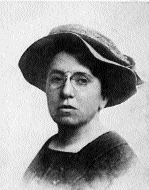
Anarchist Emma Goldman-O’Neill probably saved her from unjust execution in 1901. (Stephen Woods)
O’Neill performed his duties in a manner that obviously elicited the general approval of ordinary Chicagoans. He conspicuously fought crime and took positive action to curb corruption both within and without the force. While enjoying the goodwill of the ruling Democratic establishment, none could accuse him of being open to inappropriate political patronage. On one occasion in particular he showed himself uninfluenced by the demands of both the popular press and a public clamouring for blood. In her autobiography, Living My Life, the anarchist activist Emma Goldman, herself a Russian émigré, tells how O’Neill behaved with a sense of justice after she had been apprehended and ill-treated while in police custody. In 1901 she had been quite falsely accused in a national daily of inciting Leon Czolgosz to assassinate President McKinley in Buffalo. O’Neill questioned her personally, made it clear to his officers that he would not tolerate further intimidatory behaviour, and by insisting on proper procedures in response to a request for extradition by the state of New York probably saved her from unjust execution.
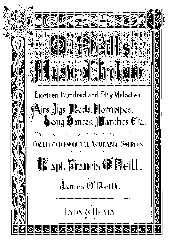
As general superintendent of the Chicago PD, he encouraged advancement within the force based on merit irrespective of ethnic background, and was responsible for the first African American officer to be promoted beyond junior rank. There is no evidence to suggest that ‘The Chief’ was given to offering favourable consideration to would-be recruits who happened also to be accomplished Irish traditional musicians. Such conduct would have offended his own code of ethics.
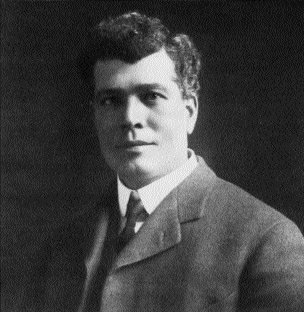
Sergeant James O’Neill (no relation)-his formal musical education allowed him to transcribe the Chief’s tunes. (Irish Traditional Music Archive, Dublin)
That said, there would appear to have been a number of talented instrumentalists in the force and none more than Sergeant James O’Neill, born near Banbridge and reared in Belfast. Apart from impeccable traditional music credentials, the sergeant had enjoyed formal musical education and was to prove the means of transcribing to manuscript a vast amount of tunes lurking in the memory of his superior.
Irish Minstrels and Musicians
With considerable assistance from his namesake, Francis O’Neill published some nine volumes (including expanded editions) of major importance between 1903 and 1924. His first collection, The Music of Ireland, contains no fewer than 1,850 melodies, and The Dance Music of Ireland (1907) as many as 1,001.

George Petrie-‘scarifies Bunting’.
Although his methodology did indeed attract a measure of criticism, he seemed to have accepted this as endemic to the role of the collector. One of the final points he made in his Irish Minstrels and Musicians (1913) was:
Bunting abuses both Moore and Stevenson for tampering with the ancient melodies. Petrie, a personal friend, scarifies Bunting, and is himself in turn with Walker and Dr. Ledwich, called to account for certain shortcomings by his old associate, Prof. Eugene O’Curry, while Sullivan condemns the whole lot, or damns them with faint praise.
Of all his publications O’Neill’s Irish Minstrels and Musicians is perhaps of most interest to the reader seeking background information to the development of the Irish music tradition rather than amassing a vast number of tunes. It is a large volume, profusely illustrated, and containing comment, opinion, analysis, and historical data as well as pen portraits of a large number of musicians, collectors, and other writers both living and deceased at the time of publication. Some might take issue with the author’s editorial management, and not all would agree with his every thesis. It is nonetheless an impressive labour of love and scholarship. O’Neill wrote with characteristic robustness, nor did he confine his comment to the musical ability of some of his subjects. For example in the course of his assessment of the Bostonian uilleann piper Edward Jones, known as ‘The Kid’, he had this to say:
Undersized and boyish-looking for his age, he soon fell victim to the blandishments of impressionable females, and was caught in the meshes of matrimony while yet in his teens
And later:
Much as mankind is inclined to condone the failings of those conspicuously endowed with artistic talent, nothing short of reasonable rectitude in our idols will ensure permanent popularity. Having fallen from his pedestal, ‘Eddie’ Joyce, the erstwhile paragon of pipering, returned to his home town in shattered health and waning fame.
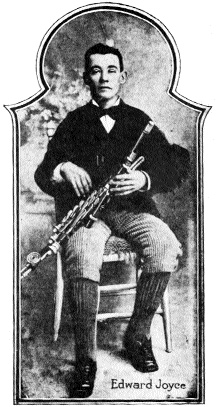
‘Eddie Joyce…returned to his home town in shattered health and waning
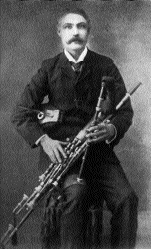
Compare the above to his comments on William Rowsome, another piper and member of a Dublin musical dynasty of County Wexford extraction, whom he met in the course of a visit to Ireland in 1906:
But the spirit of the music was in the performer, unmistakably, for while he touched the keys of the regulators airily and in good rhythm, his eyes sparkled with animation and his whole anatomy seemed to vibrate with a buoyancy which found suitable expression in the clear tones of his chanter.
One of the great joys of dipping into Irish Minstrels and Musicians is that the exercise will almost inevitably be rewarded by uncovering a further gem of unsuspected information. For instance at the end of a section on the Derrynane piper Patrick O’Sullivan, associated in his day with the retinue surrounding Daniel O’Connell, O’Neill concludes by informing his readers that ‘not everyone is aware that Thomas Sullivan, a famous military band master and father of Sir Arthur Sullivan, was also a native of Kerry’.
Lack of recognition in Ireland
Francis O’Neill survived his wife Anna by some two years. He died in 1936 and was buried in Mount Olivet cemetery. Since his retirement the couple had enjoyed a comfortable life-style, owning a farm in Illinois and a holiday-house in Mississippi, in addition to the family home in Chicago.
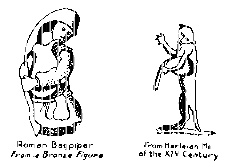
‘The Bagpipe, its Antiquity and Distribution’-drawings from O’Neill’s Irish Minstrels and Musicians.

He bequeathed his extensive library and papers to the University of Notre Dame where they are now assembled as a cohesive resource. It was a sad reflection of the times that his generosity to that institution did not seem to raise as much as a whisper of envy on the part of educational establishments in the country of his birth. Nor was he given due recognition in Donal O’Sullivan’s Irish Folk Music and Song (1952), a work which might be regarded as carrying an ‘official’ imprimatur in that it was published by the Cultural Relations Committee of the Department of Foreign Affairs. With notable exceptions, roughly a further quarter century was to pass before Irish academics began to show interest in the rich store of musical tradition lying under their noses.
There have been moves to commemorate the great collector in Tralibane, but to-date his work and life remain unmarked by statue, bust, or even plaque in his native land. Happily this is about to change. Preparations are at an advanced stage for the opening on 14 April 1999 of the Chief O’Neill Hotel in Smithfield, Dublin. Within the hotel complex, but operating as a separate entity, provision has been made for Ceol, a large and elaborate centre devoted to the theme of the Irish folk music tradition, a fitting monument indeed to the late Francis O’Neill.
Bill Meek is a radio producer in RTÉ and was a folk music correspondent for the Irish Times 1971-1992.
Further reading:
F. O’Neill, Irish Minstrels and Musicians (Chicago 1913, Cork 1987).
N. Carolan, A Harvest Saved (Cork 1997).
















